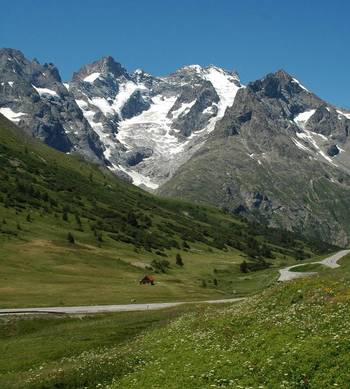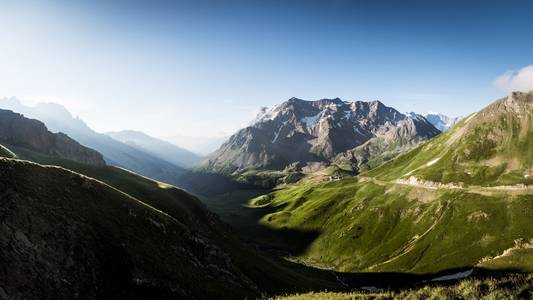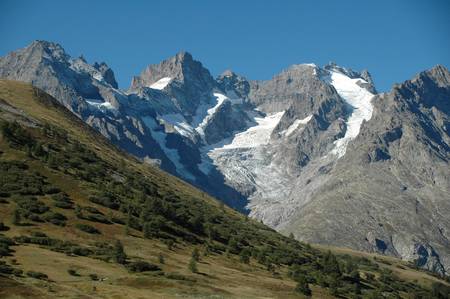The villages La Grave and Villar d'Arène are nestled at the foot of two mythical mountain passes that are Tour de France classics: the Col du Lautaret (2057 m) and the Col du Galibier (2642 m). At the Lautaret there is a stunning view of several mountain massifs: La Meije, Combeynot and Cerces. At the Galibier, the Barre des Ecrins as well as the summits of Savoie and Queyras join the feast.
In summer both mountain passes are accessible on foot, by bike or by car. Follow the GR50 hiking trail from Villar d’Arène to the col du Lautaret or climb the legendary roads on a bike or an E-bike.
The Lautaret Road

The Lautaret Road is one of the most beautiful tourist roads of the Alps. This scenic route is open to cars all year and offers a marvelous view of the summits of the Ecrins.
Combined with the Montgenèvre Pass, it is also one of the most direct routes from France to Italy. Through the centuries, the Lautaret had a great strategic importance. As early as Antiquity, a Roman road crossed the pass. From the Middle Ages to the Napoleonic era, the road or mule track was restored at regular intervals when troops needed to pass. The modern road opened in 1859 thus giving tourism in the area a head start.
The Lautaret road connects Grenoble to Briançon, the Hautes-Alpes to Oisans and Isère, the Romanche Valley to the Guisane Valley, also called Serre Chevalier Valley. It also marks the frontier between the Northern and the Southern Alps. When passing the Lautaret, you should definitely take the time to stop to enjoy the view, go for a drink or a walk.
The Galibier Road

This slightly austere, but oh so spectacular mountain pass is open to cars, motorbikes and bikes from around the end of May to mid-October, depending on how much snow there is.
The strategic importance of this barren ridge that formed the frontier between France and the Savoie for many years justified the construction of a military road in 1891. Until 1978 the highest point was at 2556 m, then the tunnel had to close for renovation and both the road and the last bit of road leading up to the ridge was built.
When are the Lautaret and Galibier roads open?
The Lautaret road remains open all year. In winter time, it can close temporarily when there is high avalanche risk or very strong winds.
The Galibier road closes at the first big snow fall, generally sometime in October, and opens for the summer season around the end of May.
Col du Galibier webcam
Follow the conditions on the Lautaret Mountain Pass live thanks to this webcam that is installed at the summit.
The Tour de France at the Col du Galibier
The Galibier Mountain Pass is the alpine pass with the most crossings ticked off on its Tour de France dance card, more than sixty in all. The Tour crossed the Galibier for the first time on July 10th 1911.Emile Georget, winner of that day’s stage, arrives at the top of the col du Galibier, stops for a refreshment and exclaims that it’s the hardest thing he’s ever done. He had just climbed the old Galibier road which had an average gradient of 9, 6 %. Only three riders managed to climb the col that day without getting off their bikes.
The Tour crossed 23 times on this steep and narrow track before the new road opened in 1938. From then on, a much easier average of 6, 9 % led to the dazzling exit of the dark tunnel some 100 m below the col.
In 1979 the Tour crossed the summit for the first time. Three hairpin bends at a 10% gradient and another 100 m put the Galibier in the most difficult category, among the HC climbs.
Cycling routes towards the Galibier and Lautaret Mountain Passes
Today, the old Galibier road is a great mountain bike descent.














